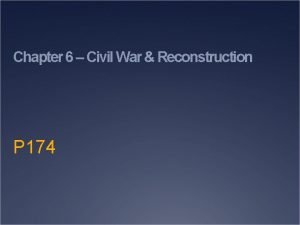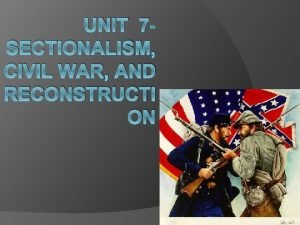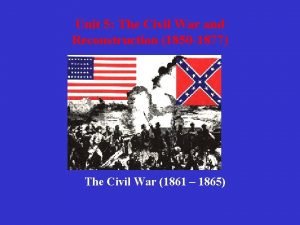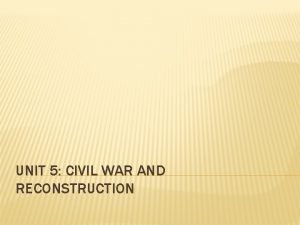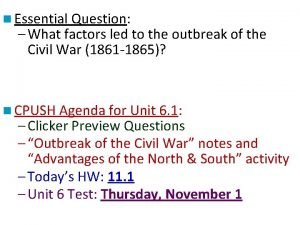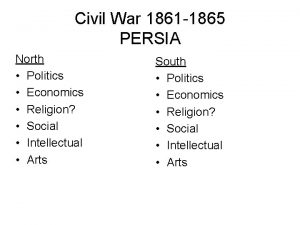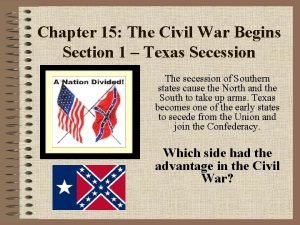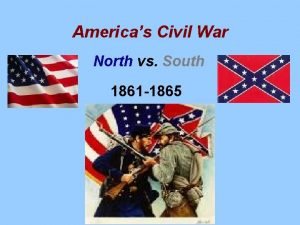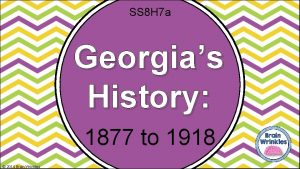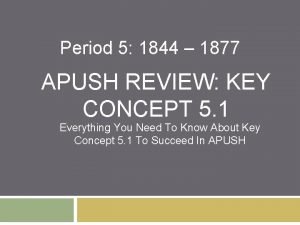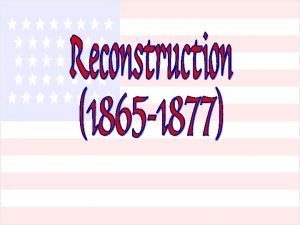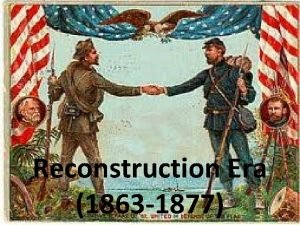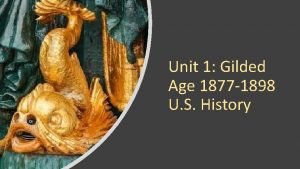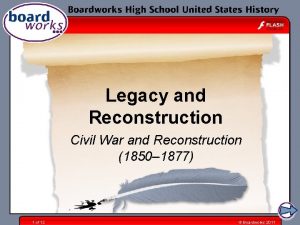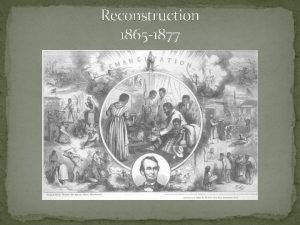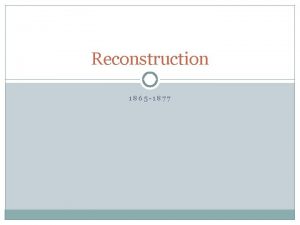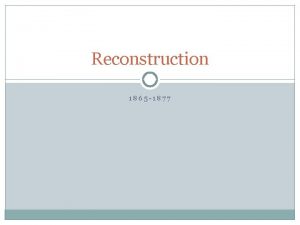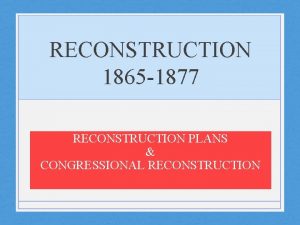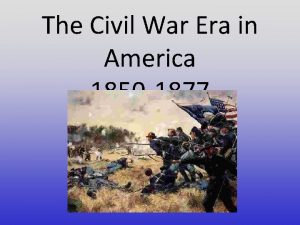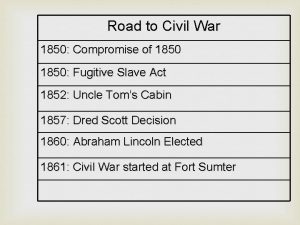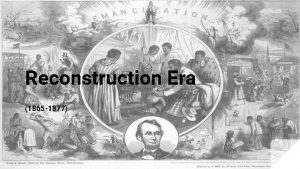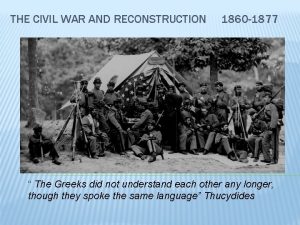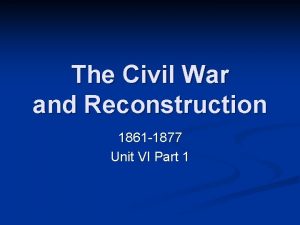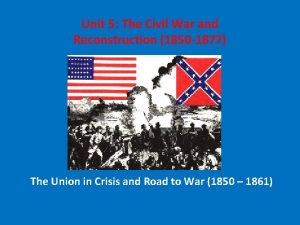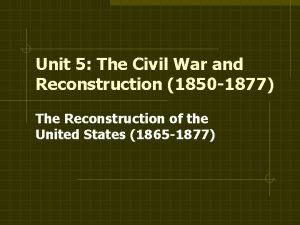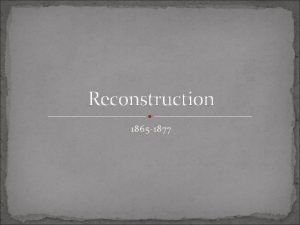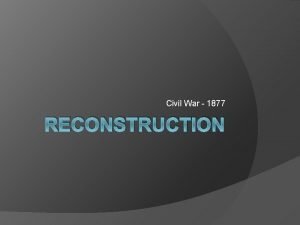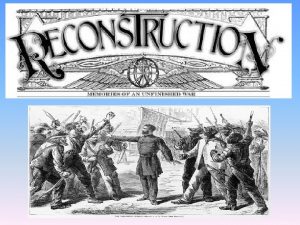Crisis Civil War and Reconstruction 1850 1877 Identifications




























- Slides: 28

Crisis, Civil War, and Reconstruction 1850 -1877

Identifications and Unit Questions- Chapter 3 Describe the growing divide caused by slavery How were slaveholders views upheld by the federal government during the 1850’s Analyze and assess the events that led to the Civil War. Describe the advantages the north enjoyed during the Civil War. Analyze the impact the Civil War had on the north and the south (economic, political, social) Describe how Congress and the President differed on Reconstruction Assess the effect Reconstruction had on the south Wilmot Proviso Free Soil Party Compromise of 1850 Popular Sovereignty Kansas- Nebraska Act Bleeding Kansas Dred Scott v. Sanford John Brown Abraham Lincoln Republican Party Jefferson Davis Confederate States of America Crittenden Compromise Fort Sumter Robert E. Lee Ulysses S. Grant Emancipation Proclamation Anaconda Plan Total War Reconstruction 13, 14, 15 Amendments Radical Republican Du jure segregation

Union in Crisis The north had developed an industrial economy The south developed an agricultural economy based on slavery The issue of slavery and its expansion began to divide the north and south during the first half of the 1800’s To prevent the expansion of slavery David Wilmot proposed Wilmot Proviso political (where would slavery expand? ) and moral (abolition) banned slavery in new territory acquired. It never became a law but caused more division between the two regions Senator John Calhoun preventing the expansion of slavery would violate the Fifth Amendment because it would deny citizens property without due process of law. Since slaves were property it was unconstitutional to deny this expansion

New Political Parties and Compromise The Wilmot Proviso provided the basis for the formation of the Free Soil Party. did not support abolition could support the exclusion of slavery in the new territories. ideas supported by the Northwest Ordinance and the Missouri Compromise. Martin Van Buren was their presidential candidate in 1848 1850 California applied for admission as a free state. Compromise of 1850 allowed California to be free but the other new territories would decide the issue of slavery by popular sovereignty (PEOPLE DECIDE TO PERMIT SLAVERY OR NOT). This undid the Missouri Compromise CA admitted as a free state and other issues that dealt with slavery and territorial acquisition The Compromise of 1850 also included the Fugitive Slave Act


Fugitive Slave Act and Dred Scott Decision Fugitive Slave Act. Allowed the arrest of any person that was accused of being a runaway slave, denied a jury trial to fugitive slaves, and required citizens to help capture runaway slaves Many northerners resented that the federal government forced them to support the slave system northern states passed personal liberty laws that nullified the Fugitive Slave Act 1857 Supreme Court decision (Dred Scott vs Sanford) led to more division between the north and the south federal support for the expansion of slavery Dred Scott was a slave from Missouri that had sued for his freedom and the case was taken to the Supreme Court. His lawyers argued that since he lived in Illinois and Wisconsin, free territory, he should be considered free court ruled against Scott , said that African Americans were not citizens and Congress did not have the power to ban slavery in the territories because it could deprive citizens of their property

The Kansas- Nebraska Act and “Bleeding Kansas” Nebraska territory was for the purpose of a transcontinental railroad but it became a proslavery bill 1854 Stephen Douglas, senator from Illinois, introduced a bill to establish this area as a free territory southern senators objected. Bill was rewritten Nebraska was free and Kansas was open top popular sovereignty Many northerners said this was against the Missouri Compromise, that the federal government was supporting slavery Radical opinion in the north- abolition- became a common view of many northerners Proslavery and antislavery forces rushed into the new territories and by 1855 two separate governments were established in Kansas

The Kansas- Nebraska Act and “Bleeding Kansas” 1856 - Proslavery forces attacked free state town of Lawrence, KS Two days later in Pottawatomie Creek, KS John Brown a radical abolitionist attacked and murdered five proslavery settlers Civil war between these forces in Kansas for the next few months. This period became known as “Bleeding Kansas” In Congress Charles Sumner a senator from Massachusetts was attacked by Congressman Charles Brooks on the senate floor after speaking out against slavery created a martyr for the north and turned the sentiment of many outside of the south against slavery. “ how can a barbarous community and a civilized community constitute one state. We must either get rid of slavery, or get rid of freedom” Ralph Waldo Emerson


The Emergence of the Republican Party Political parties began to split along sectional lines. Democrats split into southern and northern factions Whigs wilted under the strain of the Kansas- Nebraska Act Know Nothing Party emerged to support Americanism Many smaller parties merged in 1854 and became the Republican party Republicans included abolitionists, business leaders and northerners opposed to the Fugitive Slave Act and others opposed to the expansion of slavery quickly became a force and captured 105 seats in the House in the election of 1854. 1856 they nominated Charles Fremont as their presidential candidate won many of the northern states but Democrat James Buchanan was elected president. Buchanan promised to stop agitation on the issue of slavery. Many Republicans thought Buchanan lacked the backbone to stand up to southerners that dominated the Democratic party


Lincoln- Douglas Debates Stephen Douglas wanted to be president and he was one of the few Democratic leaders to have the support of both sections of the country Abraham Lincoln was a former congressman and a small town lawyer. He opposed Douglas for an Illinois Senate race in 1858 Douglas supported popular sovereignty and designed the Kansas. Nebraska Act The two met for a series of debates. Douglas argued his point for popular sovereignty and Lincoln argued against the expansion, but not the abolition, of slavery These debates were attended by thousands of people and were the force that led Lincoln to national prominence Lincoln lost the election to the Senate, but he became a national; figure

John Brown and the Raid on Harpers Ferry Radical abolitionist John Brown thought that violence was the best way to defeat slavery Fall of 1859 Brown and a band of followers attacked the federal arsenal at Harpers Ferry, Virginia hoping to inspire an armed uprising of slaves- none joined Brown was captured within two days, put on trial and hanged Brown became a martyr for antislavery, set off panic across the slaveholding south and allowed southerners no reason to distinguish between the abolitionist and Republicans


Election of 1860, Secession and War “ The Greeks did not understand each other any longer, thought they spoke the same language” Thucydides Americans had many questions on their minds during the election of 1860 - the Kansas crisis, Dred Scott decision, expansion of slavery and states rights Slave holders in the south wondered would radical northerners conspire to eliminate slavery and prevent each state making decisions on its expansion. Even non- slaveholders in the south felt their way of life was under attack Would each region of the country accept a president from another region? Could the Union survive?

Democrats Divide, Whigs and Republicans Nominate Candidates The 1860 Democratic Party argued over slavery and eventually split into two groups- one that was pro- slavery, one that supported popular sovereignty and supported Stephen Douglas The northern group nominated Douglas Southern Democrats nominated John Breckenridge who was for expanding slavery into the new territories Whigs and Know- Nothings created a new party- Constitutional Union Party. Nominated John Bell of Tennessee Promised to uphold the Constitution and he was against sectional politics Republicans nominated moderate Abraham Lincoln. wanted slavery to end and they wanted each state to control their own institutions against the expansion of slavery but there would be no interference where it already existed. Lincoln won the election and he did not receive any electoral votes from the south. The election of 1860 demonstrated there were no national political parties, the north and the south were two political entities.


Election of 1860

The Union Collapses The election of Lincoln convinced the south that they no longer had a voice in national government December 20 South Carolina voted for secession, over the next few weeks six other states of the deep south left the union. February 1861 the Confederate States of America are formed with Jefferson Davis as their president. They adopted a constitution that allowed each state independence and protected slavery. Not all people in the south supported the Confederacy Some politicians sought a compromise to solve the issue of slavery. John Crittenden plan would allow slavery south of the Missouri Compromise line and the federal government would reimburse slaveholders for un returned slaves. This was known as the Crittenden Compromise and it was defeated by the senate President Buchanan did little to stop secession and just waited out the last few months of his term


End of the Waiting Game Lincoln knew he faced a great task when he took office Inaugural address was conciliatory toward the south He had no intention to interfere with slavery where it existed, but he would preserve the Union. There would be no war unless the south started it The southern states seized federal forts and arsenals. In South Carolina April 1861 Fort Sumter, in Charleston, S. C. April 15 Lincoln asked for 75, 000 Union troops to fight against the confederacy The Confederacy began to raise troops and Arkansas, Tennessee, and North Carolina left the Union Both sides predicted a short war…. .


The First Modern War, Advantages and Disadvantages for Both Sides The Civil War was the first modern war. New technologies and devices mobilized men and materials- railroad transport, artillery, repeating rifles, ironclad ships, telegraph, trenches, wire entanglements were all battlefield devices used for the first time Advantages for the north: industrial capacity (iron, weapons, textiles, shoes), population (4: 1) transportation (more miles of railroad), finance, established government, navy Advantages for the south: had more experienced military commanders (Robert E. Lee), had a military tradition and a history of expansionism, the southerners were more highly committed to their cause


War Strategies § § § North- Had to conquer the Confederacy on southern soil South- Had to defend their territory until the north became tired of fighting Northern generals developed the Anaconda Plan to defeat the south. They wanted to control the coastlines and the Mississippi River and slowly squeeze the south. The southerners could not receive supplies from the outside.


The War The first battles took place on the east coast, mostly in Virginia. Both sides were trying to capture the other sides capitals ( Washington, D. C. and Richmond, VA) 1861 -1863 -Nobody could gain an advantage and a stalemate occurred. Many in the north and south wanted peace Many were shocked by the causalities produced by the new weapons. Photography allowed the images of war to be seen by people far removed from it Poor medical care ensured that many of the wounded died from infection

 Unit 4: civil war and reconstruction
Unit 4: civil war and reconstruction Civil war and reconstruction study guide
Civil war and reconstruction study guide Chapter 6 civil war and reconstruction
Chapter 6 civil war and reconstruction Civil war and reconstruction achieve 3000 answer key
Civil war and reconstruction achieve 3000 answer key Unit 5 civil war and reconstruction
Unit 5 civil war and reconstruction Reconstruction vocabulary words
Reconstruction vocabulary words Toward civil war lesson 3 secession and war
Toward civil war lesson 3 secession and war Why was the civil war the first modern war
Why was the civil war the first modern war Myasthenia gravis sauna
Myasthenia gravis sauna Civil rights webquest
Civil rights webquest Civil war advantages and disadvantages chart
Civil war advantages and disadvantages chart Civil war advantages and disadvantages chart
Civil war advantages and disadvantages chart States rights
States rights North and south states civil war
North and south states civil war North and south states civil war
North and south states civil war Ppt
Ppt Guernica 1936
Guernica 1936 Georgia history timeline 1877-1919
Georgia history timeline 1877-1919 Joseph pulitzer apush
Joseph pulitzer apush Apush period 5 key concepts
Apush period 5 key concepts Compromise of 1877
Compromise of 1877 The great railroad strike of 1877 was provoked by:
The great railroad strike of 1877 was provoked by: Whats the compromise of 1877
Whats the compromise of 1877 Whats the compromise of 1877
Whats the compromise of 1877 1877 golden 1
1877 golden 1 Tanssija 1877-1927
Tanssija 1877-1927 Define reconstruction era
Define reconstruction era The gilded age 1877 to 1898 worksheet answers
The gilded age 1877 to 1898 worksheet answers Great railroad strike of 1877 significance
Great railroad strike of 1877 significance


